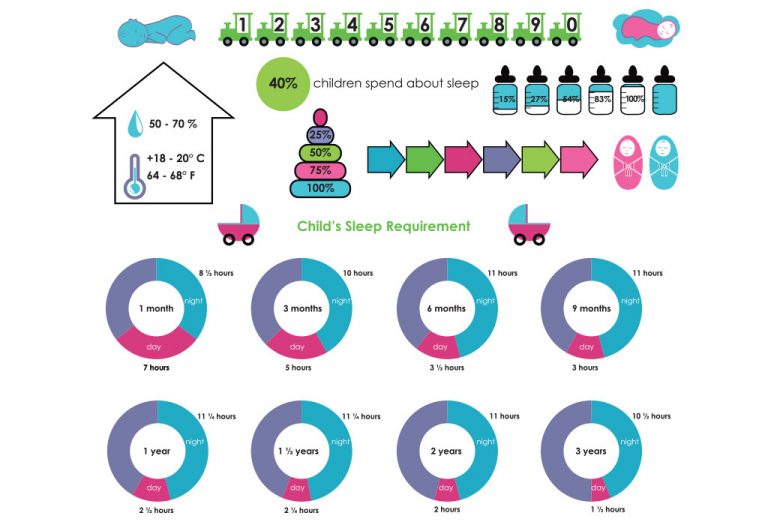Ferber Method of Sleep Training: When to Start & How It Works?
As parents, one of the hardest things to do in the early stages of parenthood is to put your child to sleep. Newborns are ridiculously fussy in most cases, and getting them to sleep can be a difficult task. While you may have tried everything from patting them to singing lullabies, none of those methods would seem to work consistently. Some parents turn to structured approaches like the Ferber method of sleep training, which focuses on teaching your baby to self-soothe and fall asleep independently. Finding the right technique requires patience and understanding, as every baby is unique and responds differently to various sleep training methods.
Ferberizing is a method which was developed by paediatrician Richard Ferber, which helps parents make their child go to sleep quickly. The method has received polarizing reactions from other experts and parents alike – some find that it works exceedingly well, while others claim that it is psychologically harmful to the baby. In this article, let us take a deeper look at what Ferberizing is, and other details about this practice.
What Is the Ferber Sleep Method?
Developed by Richard Ferber, it depends upon the parent letting the child go to sleep by himself from an early age. The method encourages parents to let the baby soothe and calm himself, in order to go to sleep. It depends on the child being ready both emotionally and physically and can be taught to the child when he is older than six months of age.
In the Ferber method, parents are instructed to put the baby down in his crib after a loving routine every night. However, the baby has to be awake when he is placed in his crib. This is the most crucial part of this method and forms the crux of his idea that the child will learn to go to sleep by himself.
How Does It Actually Work?
Here’s how the Ferber method is actually executed:
- The important thing to note is that the baby should not already be asleep when you put him down in his crib. You need to leave the room with the baby still awake. If he seems to cry for your attention, you can always check up on him, but again, leave the room when he is still awake.
- The next step is to gradually increase the time between each time you check up on him each night.
- This means that the baby gets more time to soothe himself when he fusses and learns to sleep off all by himself soon.
- You do not need to have a specified number of minutes between each check, and can just go with your intuition.

What Is the Right Age to Start With the Ferber Method for Your Baby?
If you plan to start using the Ferber method, the age of your baby must be older than 6 months at the least. Doctors recommend that you do not start sleep training until the baby is at least half a year old so that their eating schedules are not affected. However, you should definitely start training before he becomes a year old, as a lot of routines or patterns become ‘set’ into his life by the time he becomes a year old.
Ferber Sleep Training Method Chart
By following a structured approach, often referred to as the Ferber method schedule, parents can gradually reduce their baby’s reliance on external soothing techniques.
| Day | First Check-in After | Second Check-in After | Third Check-in After | Subsequent Check-in After |
| 1 | 3 minutes | 5 minutes | 10 minutes | 10 minutes |
| 2 | 5 minutes | 10 minutes | 12 minutes | 12 minutes |
| 3 | 10 minutes | 12 minutes | 15 minutes | 15 minutes |
| 4 | 12 minutes | 15 minutes | 17 minutes | 17 minutes |
| 5 | 15 minutes | 17 minutes | 20 minutes | 20 minutes |
| 6 | 17 minutes | 20 minutes | 25 minutes | 25 minutes |
| 7 | 20 minutes | 25 minutes | 30 minutes | 30 minutes |
How to Use This Method to Get Your Baby to Sleep
You have to follow a few Ferber method steps so that the baby goes to sleep by himself within a few days.
- The first step is to develop a bedtime routine for your child, to be done before he is put to bed. This can be anything from reading a bedtime story to singing a lullaby – just make sure your child is involved in the actions you do.
- Then, you have to put your child to sleep in his crib or sleeping space while he is drowsy, but still awake. Ensure that the environment is suitable for sleeping, which means that it should be silent and dark.
- You have to leave the room while the child is still awake. If the baby cries for your attention, you are welcome to check up on him. Go over to him and comfort him, using pats and comfortable sounds. Then, leave the room when he is awake.
- Initially, check up on the baby in intervals of three, five and then ten minutes if he does not seem to stop crying. Gradually, you have to increase the time between the checks with each passing day. This process is called ‘gradual extinction’, and the time between checks should get to twenty minutes with time.
- The baby learns to soothe himself eventually, and you will find that the number of times he cries decreases as the day passes.
- This means that the baby is able to go to sleep on his own, without much of your help.
How Flexible Is Ferberization?
The methods are extremely flexible, and you can vary the intervals between the times you check up on your child so as to fit your needs and circumstances. If you feel that your child needs more time to adapt to this gradual extinction, you can always reduce or not increase the time between the check-ups until he gets a hang of it.
How Long Does the Ferber Method Take?
The Ferber Method typically takes 3 to 7 days to show significant improvements in a baby’s sleep patterns, though this can vary depending on the child’s temperament and consistency in following the method. Some babies may adapt to the schedule within just a few nights, while others may take a little longer to adjust.
Limitations of Ferber Sleep Training Methods
There are a few limitations to this sleep training method, as given below.
1. Younger infants
Sleep training methods cannot be used for children who are younger than six months of age, as on most days they need to feed in the middle of the night.
2. Can be traumatizing
If the baby has a fear of being left alone or have a conditioned vomiting response, it would be better for you to not try sleep training using gradual extinction. If the baby has any fears or bad memories associated with the place he sleeps in, trying gradual extinction as advised in the Ferber method can result in your child vomiting or being overcome by fear.
3. It does not teach your child to sleep by himself
Richard Ferber himself has acknowledged that Ferberization does not include teaching the child to go to sleep all by himself – rather, the children are simply encouraged to figure out how to go to sleep all by themselves. This means that your child may simply refuse to go to sleep or cry extensively until he gets your attention.

Is the Ferber Training Method the Same as the Cry-It-Out Method?
Ferber method is not the same as cry-it-out methods, although both are sometimes confused in the place of each other.
- Cry-it-out methods advise the parents to let the baby cry himself to sleep, and deny the child from getting the attention of his parents.
- In contrast, the Ferber Method involves the parents giving their attention to the child each night, albeit at longer intervals.
Myths and Facts About Richard Ferber Method
Over the years, there have been a lot of misconceptions about Ferberizing your baby. Some of these are:
1. Myth
Ferberizing advises the parents to let their children cry themselves to sleep.
Fact: In fact, parents are advised to cater to their child if he craves their attention. However, gradual extinction means that the parents wait a tad longer each time to soothe their child.
2. Myth
In Ferberizing, the baby has to cry until she vomits.
Fact: While it may be true that the child may vomit if he cries for a long time, it does not occur as frequently as implied. Even if he does vomit, the parents are expected to take it in their stride and as a part of the sleep training- just clean up the mess before you leave the room!
3. Myth
Ferber methods are easy to teach and implement.
Fact: While the baby is expected to acclimatize in a couple of weeks, it may take longer and may turn out to be a more arduous process in some cases.
4. Myth
The Ferber method is not flexible.
Fact: Parents are encouraged to use their intuition rather than a fixed chart to know when to soothe their child and adjust their timings in order to make the baby feel more at ease with the training.
When to Consider Stopping the Ferber Method
While the Ferber Method is effective for many families, there are situations where you might need to pause or stop the approach:
- Persistent Distress: If your baby continues to cry inconsolably for extended periods beyond the typical adjustment phase (3-7 days), it may indicate that the method is not suitable for them.
- Health Issues: If your baby is teething, unwell, or experiencing discomfort, it’s best to pause the training and revisit it when they are feeling better.
- Inconsistent Results: If you’ve followed the Ferber method schedule consistently for over a week without noticeable improvement, consider reevaluating your approach or consulting a pediatrician.
- Parental Discomfort: If the process causes significant stress for you or your partner, it’s okay to explore alternative sleep training techniques that align better with your parenting style.
FAQs
1. Is the Ferber Method suitable for older toddlers?
The Ferber Method can work for older toddlers, but the approach may need slight adjustments. Toddlers often have stronger emotional reactions and may require more reassurance during the process. Pairing the method with a bedtime routine tailored to their developmental needs can improve its effectiveness.
2. Can the Ferber Method be adapted for twins or multiples?
Yes, the Ferber Method can be adapted for twins or multiples, but it requires extra coordination. Parents can stagger bedtimes or focus on training one baby at a time to minimize disruptions. Using white noise machines can help mask one baby’s crying and prevent waking the other.
3. What if my baby vomits during Ferber sleep training?
Some babies may vomit as an extreme reaction to prolonged crying. If this happens, calmly clean them up without offering additional soothing, then place them back in their crib and continue with the Ferber method schedule. This ensures consistency while addressing their immediate needs.
Ferber sleep training methods are extremely misunderstood, but it can work wonders when it is practised correctly. However, you should not try it when the baby is too young, and not try it at all if you think that your baby has irrational fear problems with being left alone.
References/Resources:
1. Etherton. H, Blunden. S, Hauck. Y; Discussion of Extinction-Based Behavioral Sleep Interventions for Young Children and Reasons Why Parents May Find Them Difficult; Journal of Clinical Sleep Medicine; https://jcsm.aasm.org/doi/10.5664/jcsm.6284; November 2016
2. Self-Soothing: Help Your Baby Learn This Life Skill; American Academy of Pediatrics; https://www.healthychildren.org/English/ages-stages/baby/crying-colic/Pages/Self-Soothing-Helping-Your-Baby-Learn-This-Life-Skill.aspx
3. Healthy Sleep Habits: How Many Hours Does Your Child Need?; American Academy of Pediatrics; https://www.healthychildren.org/English/healthy-living/sleep/Pages/healthy-sleep-habits-how-many-hours-does-your-child-need.aspx
4. Shaughnessy. A; Getting an Infant to Sleep: Graduated Extinction and Sleep Fading Are Effective; American Family Physician; https://www.aafp.org/pubs/afp/issues/2016/1101/p750.html; November 2016
5. When and How To Sleep Train Your Baby; Cleveland Clinic; https://health.clevelandclinic.org/when-and-how-to-sleep-train-your-baby
6. Helping baby sleep through the night; Mayo Clinic; https://www.mayoclinic.org/healthy-lifestyle/infant-and-toddler-health/in-depth/baby-sleep/art-20045014
7. Park. J, Kim. S, Lee. K; Effectiveness of behavioral sleep interventions on children’s and mothers’ sleep quality and maternal depression: a systematic review and meta-analysis; Scientific Reports; https://www.nature.com/articles/s41598-022-07762-8; March 2022
Also Read:
Methods to Make Baby Sleep at Night
Chair Sleep Training Method for Babies
Pick up and Put Down Sleep Training Method
No-Cry (No-Tears) Sleep Training Method for Babies
Was This Article Helpful?
Parenting is a huge responsibility, for you as a caregiver, but also for us as a parenting content platform. We understand that and take our responsibility of creating credible content seriously. FirstCry Parenting articles are written and published only after extensive research using factually sound references to deliver quality content that is accurate, validated by experts, and completely reliable. To understand how we go about creating content that is credible, read our editorial policy here.






















